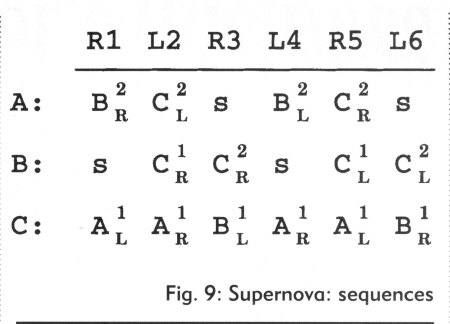|
Supernova I
don't remember exactly why we called this pattern invented at the Lodi
festival a Supernova, but maybe it was because of all the clubs that
seemed to emerge from the big explosion. Anyway, if you're game, here's
a triangle passing sequence that should provide a challenge and some
fun. It's based on the 7club 1-count pass-pass-self (PPS) pattern (see
the Spring 1993 Juggler's Workshop),
so that would be a good pattern to master first. Here we've added one
more juggler and three more
In
this pattern, two people perform the two roles from the 7 -club PPS; one
throws
Figs.
6, 7 and 8 show where the three jugglers throw to. An interesting aspect
of the Supernova is that, although each of A and C passes to both other
jugglers, B passes only to C. A passes only diagonal doubles, doing
outside-outside-self then inside-inside-self. B does
self-single-double (the doubles are diagonal passes), passing only to C.
Meanwhile, C throws all single passes, always throwing two in a row (R,L
or L,R) to A followed by one (R or L) to B.
Fig. 9 shows the sequences of throws for each juggler. The superscript 1 or 2 indicates either a single or a double pass to the given person (A, B or C). An "s" represents a self, and the subscript R or L is the hand that the given person is throwing to. Note that all singles are straight and all doubles are diagonal but the complexity of the pattern is hidden in the fact that one juggler does RRLL (B in Fig. 5). If the hands of both jugglers in that diagram were always alternating R and L, then the figures arrows would indeed represent the normal 1-count, with no diagonal passes.
The
one tricky part of the pattern occurs on the second count, when both
jugglers are throwing diagonal singles at the same time (A does L-L and
B does R- R). If these throws are completely symmetric, then they are
bound to collide in the middle. But the collision can be avoided
relatively easily. I suggest having juggler A throw that diagonal from
well inside (from in front of the body) to a bit outside the shoulder.
Juggler B can throw from outside the leg to a little inside (perhaps
right at the edge of the shoulder) and can also try to delay that
throw a tiny amount so that it goes behind B's diagonal pass. It doesn't
take much adjustment to avoid the collision, so passes (R to R or L to
L). As Fig. 9 shows, all three jugglers start at the same time with
their R hands. The columns in the figure represent the alternating Rand
L hand throws of the three jugglers. To simplify things, we'll have
juggler C start with four clubs, and A and B with three each.
Note
that although Ns passes are all diagonal doubles, the two inside throws
actually go straight ahead from A, since the two other jugglers are
positioned outside of those inside throws. Ns outside throws, on the
other hand, cross quite sharply relative to each other. Of Ns two
consecutive passes, the first one always goes to B (as in a 3-count
feed).
B
should pretty much face C, since that where all of Bs passes go, first
two consecutive passes (single, double) to C's right, then two passes to
C's left. Band C need to make sure to
throw normal singles and keep them from drifting too high. There is
often a tendency to throw singles undesirably high when you're looking
up to catch doubles. So be sure to pass the singles well below where
you're looking when you're catching doubles.
Also
make sure everyone's inside passes (passes going to the L hand of the
person on your left or the R hand of the person on your right) are good
and long. They should come in at shoulder level, in order to allow the
receiver to throw another club under the incoming pass. Avoid the
common error of throwing those inside passes short - that causes the
receiver to have to turn and hurry and often results in the next throw
being even worse.
Finally,
you can try the Antimatter Supernova, which you can do by simply having
B and C trade places and then having everyone throw to the same people
and hands as before. Be careful not to let a normal Supernova get too
close to an Antimatter Supernova!
If
you have any comments or
suggestions for juggler's
Workshop, write to: Juggler's Workshop, |



